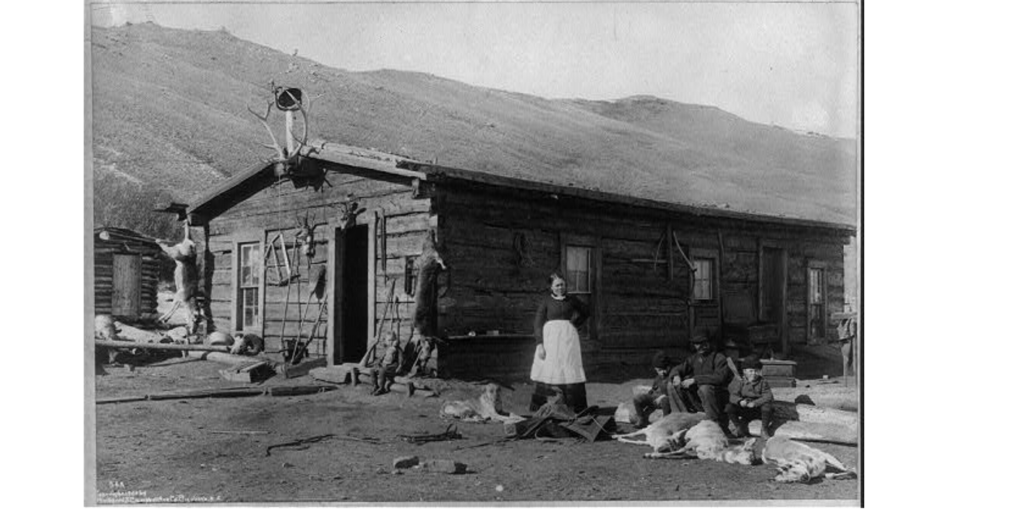
California, ca. 1900. [Photograph] Retrieved from the Library of Congress, https://www.loc.gov/item/2012649610/.
Over the course of the one hundred-year period between 1850-1950, families changed significantly. At one time family was a very patriarchal system, where the father was the breadwinner and had the final say in everything. People had little control over their fertility and any children born would to meet the family’s labor needs; education was minimal and illiteracy was high. Then, around 1850 we began to see a shift in family dynamics where women gained some (limited) power over the household and childrearing decisions. Children were increasingly seen as worthy of education and nurturing, particularly among the middle class. (Mintz and Kellog, 1989) Around the same time was the rise of industrialization, and because of this, families started to spend more time working away from home, which meant the home started to become sort of a sacred place for the family. Institutionalization played a large role in deciding what the ideal family looked like. Spending time with family started to become a more common pastime, with family dinners becoming increasingly valued. (Mintz and Kellog, 1989) After World War II, the economy began to become more and more stable, which meant (white) families could start purchasing bigger homes, and could pay for their children’s education and extra-curricular activities. The media began to depict families as closer, and paid more attention to gender roles inside the family.
Families faced various threats, including poverty, tragedy, and mistreatment. Until the late 1900s, children really did not have many rights, and this led to frequent child abuse, whether that be from parents, or from institutions that unfortunate children were put into when one or both of their parents died. Public awareness of (and concern about) domestic violence and child abuse was low until the child-saving movements of the Progressive Era (Mintz, 2004). There was a real diffusion of responsibility that occurred when it comes to child abuse, with everyone hoping that someone else would deal with it, but eventually, people began to speak up for children’s rights.
Another big threat to families was the use of children for labor. Through the mid-twentieth century children were being used to fill work requirements in agriculture, often putting their education in the backseat in order to help out the family by putting some money on the table. (United States Department of Labor Children’s Bureau, 1933) As the population increased, so did the demand for food, which in turn meant the demand for labor started growing tremendously, causing thousands of children to put down the pencil and pick up the shovel. (United States Department of Labor Children’s Bureau, 1933) But, just as child abuse gained public attention, so did child labor. Public opinion began to shift from children being a means of labor to becoming those who needed to be educated and nurtured, in order to continue the evolution of family and society. We found that through the implementation of child labor laws and compulsory schooling the role of children in families changed, turning them from economic assets to priceless and in need of protection.
Arguably the most important cog in the wheel of family is parenthood. In agrarian families, everyone worked but childcare was usually the domain of women and girls. As women began joining the industrial labor force, they could no longer single-handedly parent the child, which meant an increase in daycare facilities where parents could drop off their children for the day while they went out to work. (Dunst 2005) These operations usually were small-scale facilities run out of homes. Throughout the last 200 years, there has been an extensive rethinking in what exactly a parent should do for their child. For a while, parents would simply not send their children to school for various different reasons (was far away, wanted them to work on the farm etc). (Children’s Bureau, 1924) This was especially a problem with rural children, since they were more impoverished and uneducated. Middle-class children in cities were less needed for labor, so their days were centered more around education and less around work. Throughout all of these major historical changes, children became more central to the meaning of family. This project focused on childhood as a whole. However, if we were to take this further we think it would be interesting to delve deeper into the differences in childhood experiences depending on one’s race during this time period. Focusing on the experiences of immigrant families and Black children in a more in-depth sense would add different experiences and narratives to each decade we looked at.